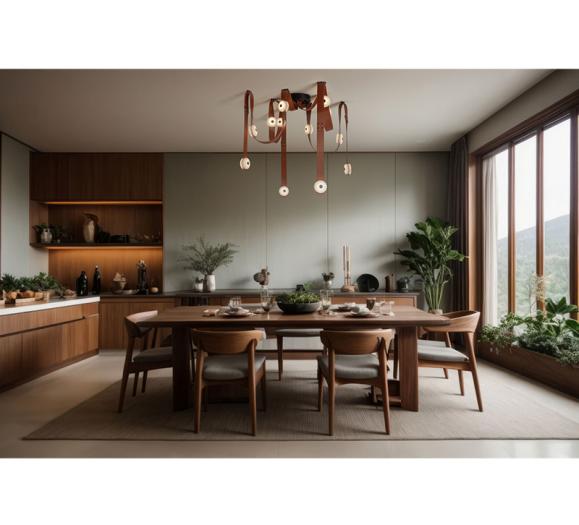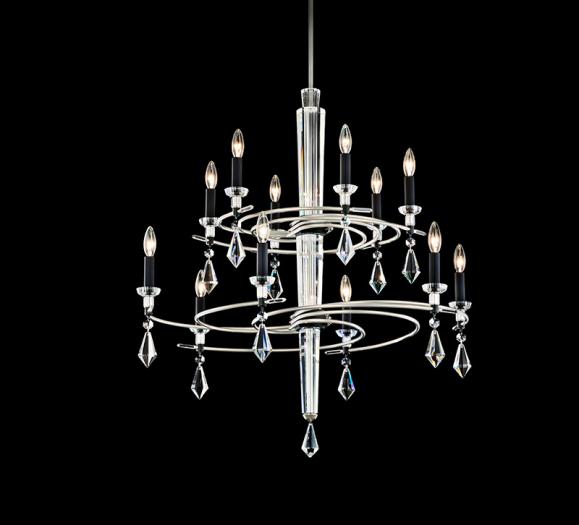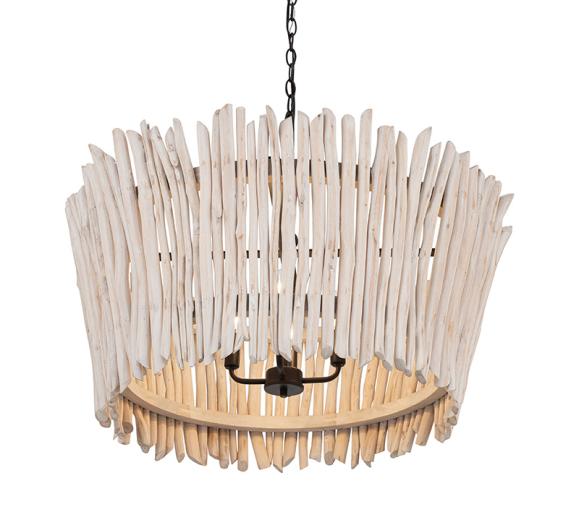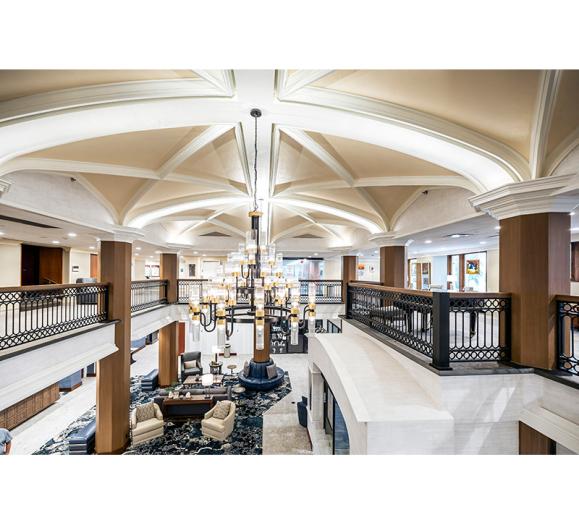At Las Vegas Market, we caught up with designers and an electrical expert about the adoption of smart lighting and appliances, how clients are reacting to technological advances and what is influencing decisions. Our panelists were Dann Foley, of Foley & Stinette Interior Design, in Palm Springs, CA; Christopher Todd Hall, of Christopher Todd Design, in Las Vegas, NV; and Steve Withey, President and CEO of Elite AV Innovations. According to our panelists, innovations in smart home are coming quickly, and while many consumers might be hesitant to go all in on making homes smart, they are laying the foundation where possible — placing the hardware and wiring for when clients are ready to proceed with smart home, which they likely will as the technology becomes more mainstream.
Below is a synopsis of our conversation that took place in Craftmade’s Las Vegas showroom. Craftmade, this panel’s sponsor, is on the cutting edge of smart technology with its ceiling fans and lighting options.
From the Craftmade Panel:
What is driving the adoption of smart technology in residential homes?
Dann Foley: When we started seeing smart technology coming into the market, it was the husbands interested in it. Now the women, the wives want it. I live in Palm Springs, where it’s 120 degrees. If I leave in the morning and forget to turn my air off, I can turn it on from my phone. My Amazon driver can go into my garage. It tells my phone that the door went up and tells me my door went down. It is the women of the home who want this convenience who are the driving force. They’re even more interested when they are getting the smart features as part of the design.
Christopher Todd Hall: In my house growing up, when the TV wouldn’t work, everyone would throw their shoes, and then I’d have to get up and slap the TV to get the picture working again. To go from that to the point we’re at now, technology allows us to do all of this so easily. We’re embracing our laziness, and we don’t want to
get up to do these things.
Steve Withey: Really, the word is convenience. It’s for the family, the kids. Smart technology can be fun and it’s becoming more commonplace now, incorporated into products like ceiling fans. The fun factor is the thing driving so much of smart home adoption.
How much do you think technolgy such as our phones and smart TVs are driving consumer awareness?
CTH: I think these devices are driving everything. I remember when CDs came out. I didn’t think there could be anything better than CDs. Now we stream music from our phones. I can’t imagine we have something better than what we have now.
Where are consumers asking for smart technology in their homes?
DF: People love the sense of control that comes with security. Not just alarms, but cameras as well. They’ll ping on your phone. If you’re watching TV, and a camera or alarm is tripped, you’ll see it there. Clients get serious when we’re talking about their security.
CTH: Drapery. When we do installs, it will drive up the cost of a drapery. The hardware is $3,000 to $4,000 just to automate the drapery.
Even if I can’t sell the client on the full automation package, I’ll ask if we can hardwire up there, so its easier down the road. Or I’ll get them to invest in one automated Roman shade so they can see the convenience.
SW: Even with wireless cameras and alarms, you still have to power those cameras and shades, so it’s important that the hardwiring is done at the design stage.
Clients are adopting smart in lighting and ceiling fans because, for example, when you’re coming home from your day, geofence on your phone knows where you are, or you might have a motion sensor, and these can trigger certain things. It can automatically turn on the ceiling fans, turn all the lights on, open the garage door. If you really want, a smart appliance can start your cup of coffee. There
are more and more items with smart technology built
into them. The market is doing a lot of the work for me as people are seeing what this technology can do every day and it’s getting them excited.
What smart features are consumers gravitating toward when it comes to ceiling fans and lighting?
SW: Voice technology is a really big one. If you don’t want to see the hockey pucks, I steer clients toward Josh AI, which is smaller than a quarter and can be installed flush on the wall in white and black. It can be incorporated on lighting panels, on the ceiling, and the technology is available to hide. We can hide speakers in the walls. You no longer have to have technology in view. Remotes are all wireless, and you can even control some remotes through your phone.
How do you design smart technology into a home and how do you convince your clients that this is a direction they want to go in?
CTH: The biggest thing was the home intercom system when I started my career. Now it’s fun taking all those out. We patch so many holes taking out those speakers. Automated drapery is the biggest thing we do.
We also focus on smart technology in appliances. It’s cool to be able to have coffee makers and appliances that I can get started on the way home from the grocery store. Technology is moving so quickly, you want to make sure to get a plug in for the drapery; it’s going to change and be uprgraded. It will be better. We try to have a system in place to upgrade in the future. I try to make my clients aware of all the things they can do, and get set up for the future now.
Some smart technology, particularly lighting, is said to help with wellness in the home. Are your clients looking for these attributes in their home design?
SW: Lutron started doing this. Lighting by color temperature. The idea is that when the sun is rising it’s in the yellow family. Might come in at 2800 or 3000 Kelvin, it might go up to 5000 or 6000 as you come through the day, and then it progresses and starts bringing the temperature down. You can adjust by season and time of day, and it can be controlled by an app on the phone.
DF: The color thing is so important, everything went LED, and everyone is still confused, including me. I keep a cheat sheet on my desk. People love to talk about lighting in terms of color. The only thing Christopher and I would have to say today is call Steve for the correct information. To designers, don’t try to do this yourself. It’s not only about putting it all together; it’s about getting it wired and keeping it working. You have to take over a closet with a control room. You have to have a proper fan and heat. To get the install done, you call Steve, but you also have to have enough knowledge to explain it to clients.
How do you get educated on new technology and what’s up and coming?
DF: Again, you can call on a ‘Steve.’ To understand it better, you come to markets, you see the new products, you have these converasitons. Technology changes so quickly and keeping up with it is difficult. I’m still confused. Having someone you can call on for the correct information is everything. When you have to build a command booth, you need someone. Especially when you get that call that your clients don’t know how to do something related to their new technology.
SW: I come to seminars like this, I do webinars and a lot of reading. I buy it, and try it out on my family. I push the limits. Can it do this? No. But I just did it. Some of it is so new, so bleeding edge, you just have to play with it.
How can manufacturers help with your education on smart technology?
SW: Demo, demo, demo. Show me the product. Let me experience it. Let me see how it works with my life. It can be an Instagram video that shows how this thing works. You can go through the LED color thing and explain and understand the colors. The old fluorescent soft and cool (soft was 3000K and cool was 5000K). I think the best way to learn is to see it.
DF: I love when manufacturer’s reps come to the office and give us demos. A lot of designers seem to hide from reps. Our rule is if I’m in the office, I tell them to come. Why wouldn’t you want to see the latest? The reps are coming to show us appliances and lights and how they work. The only way to see it is to go out and do it. You have to go to the showrooms that do it. Go to Ferguson, for example — you’ll see all this going on.
Where would you suggest a client start with smart technology in the home, especially if they are hesitant?
DF: I’m going to say kitchen because it’s the easiest. Appliances, they come ready to go. Clients end up loving the technology. Then they really want to talk about this stuff.
CTH: I would start in a room they use every day. Show them something they’d use every day. They’ll see that and say let’s do that.
SW: Focus on areas that are easy to do and give a lot of value. Timer, schedule, garage lights, entry lights, foyer, motion sensor where they make sense. The Ring doorbell. You can have those smart lights go on as soon as someone walks up, it will turn on the foyer, family room and porch lights. You can also trigger in the house so you can see who’s there.
What do you see coming next from a smart technology perspective?
DF: It can’t go any further, can it?
CTH: I was impressed with the CD. I thought that was the end of it! I think it’s so fascinating that you can just rattle off your list. Technology has come so far, even past the home. Your smart refrigerator can tell you “this is what I need in the grocery store.”
SW: Voice control. Remember the Jetsons? Now the big buzzword is AI. That’s where voice control can really take off. Turn on the kitchen lights. Alexa, turn on the TV. Everything has to be a single command right now.
With Josh AI, you can string those commands together all at one time. That’s natural language and how you want to say it. You can’t do it with the products out today, but Josh AI is the most advanced technology out
there today.






